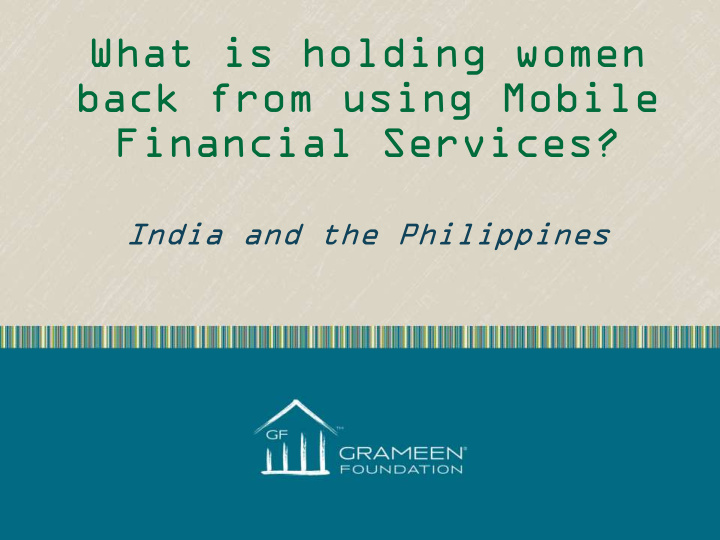



What is holding women back from using Mobile Financial Services? India and the Philippines
“The fact that the poor are alive is clear proof of their ability” Muhammad Yunus, Banker to the Poor: Micro-Lending and the Battle Against World Poverty
What we know……. The 2012 GSMA mWomen ‘Unlocking the potential’ report demonstrates clearly that there is: • Market demand from poor women for Mobile Financial Services • Scale and sustainability are achievable for Mobile Money providers through working with poor women The report also clearly outlines that women want financial services that are: convenient, reliable, secure, and private.
Cashpor – Our India experience In India, we engaged in strategic partnerships with ICICI Bank and Cashpor Microfinance to scale mobile-enabled savings services for the poor via the banking correspondent model. Our work involved establishing and creating incentive structures for the agent network, change management within the organization, setting up systems for information flows, and ensuring usability/accessibility by clients. The product has now reached 150,000 new savers, 99% of whom are women, with active client rates in the 70% range. This is far above the average in India where the prevailing active rate on basic savings accounts is estimated to be 10-15%. Money is collected at the centre meetings from customers. The savings is not compulsory. Women also do not have to own their own phone to have a savings account.
Cashpor – Our learnings • In October 2012 Grameen Foundation released a case study ‘Women, Mobile Phones and Savings’ based on the Cashpor model • This case study investigated the usage of the mobile phone in the Cashpor clients. • There were three key outcomes: • Women who own mobile phones save more often that women who have to borrow a phone (usually their husbands) • Only 35% of the women who owned or had access to phones could use them independently • Women rely on their children to perform tasks on the phones – including making and accepting voice calls.
CARD – Our Philippines Experience In the Philippines, Grameen Foundation is partnering with CARD MRI, a banking and insurance group that has three microfinance oriented banks and two insurance companies reaching over 1.8 million clients. Our effort initially focused on helping CARD launch and scale savings products for their clients. We have expanded our collaboration with CARD to include developing mobile-enable savings products in tandem with creating the business model around a last-mile rural agent network composed of clients. To date, our market research, product development, and mobile technology assistance have helped CARD to reach over 425,000 poor savers, 98% of whom are women.
CARD – Our learnings • Designing solutions: meeting women’s needs • Establishing transaction points in the village • Agent-assisted transactions to allow women without phones or airtime to participate • Leveraging existing social networks: using CARD’s own women members as agents • Successful adoption of MFS in general • 78% prefer MFS over manual system, correlated with training attendance • 88% sign-up rate, ~80%% deposit every week, ~10% withdraw • Time and cost savings (Php16 [$0.37] per deposit, Php 103 [$2.40] per withdrawal) • Improved flexibility with after-hours and weekend transactions especially casual laborers
2013 GF Usability Study GF is currently undertaking a research program in India and Philippines on ‘if and how’ poor rural women (and men) use mobile phones. Here is some preliminary findings: Ownership of a mobile phone was arguably related to income. Each state of acquiring a mobile phone – no access, borrowing a phone, owning a phone (and subsequently using MFS) seemed to be related to better economic circumstances and, in India, more social freedom for women. Features other that voice are not used as respondents don’t know how to use them (except SMS in Philippines) Indian women learned to use a mobile phone from their direct community whereas Filipino women tend to self teach. India presents a number of social challenges to women to use a mobile phone. Low literacy, lack of social mobility, and caste prejudice.
What women are not Women are NOT a target market! We are though a very attractive Total Available Market
What is Convenient, Reliable, Secure, and Private to you All of us make financial decisions based on a number of different influencers: • • Geographical Religion • • Culture Community (broad and direct) • • Family Values Generational experience • Education What is convenient, reliable, secure and private to you? What is it to these people • Single mother of 2 school age children, micro-entrepreneur in Tunisia • Sri Lankan Migrant worker (housekeeper) in Dubai, daughter, no children, seeking marriage
What women deserve** Acknowledge Me Design for Me Market to Me Support Me Help Me grow **(according to Me)
Connecting The World’s Poor to their Potential .
Recommend
More recommend